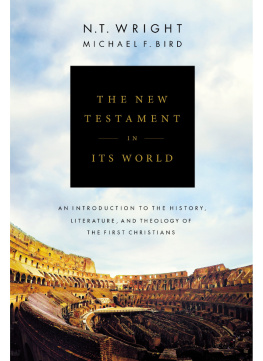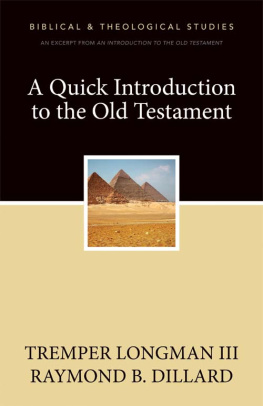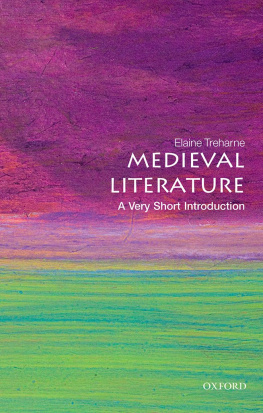References
Chapter 1
Augustine, Confessions, III. iv, trans. Henry Chadwick (Oxford: Oxford University Press, 1991), 40.
Chapter 2
Kenneth Burke, Literature as Equipment for Living, in Contemporary Literary Criticism, 2nd ed., ed. Robert Con Davis and Ronald Schleifer (New York: Longman, 1989), 81.
Chapter 3
Some early manuscripts do not have this statement in the gospel. Even if it is not original, it certainly meshes with Lukes portrayal.
Chapter 4
The Antichrist, trans. Walter Kaufmann, in The Portable Nietzsche (New York: Viking Press, 1968), 618.
Chapter 5
D. H. Lawrence, Apocalypse (New York: Viking, 1932), 1718.
Ibid., 22.
Further reading
Alter, Robert, and Frank Kermode, eds. The Literary Guide to the Bible. Cambridge: Harvard University Press, 1987.
Badiou, Alain. St. Paul: The Foundation of Universalism. Stanford: Stanford University Press, 2003.
Barr, David L. New Testament Story: An Introduction. Belmont, CA: Wadsworth, 2001.
. Tales of the End: A Narrative Commentary on the Book of Revelation. Santa Rosa, CA: Polebridge, 1998.
Besserman, Lawrence. Chaucers Biblical Poetics. Norman: University of Oklahoma Press, 1998.
Bible and Culture Collective. The Postmodern Bible. New Haven: Yale University Press, 1995.
Castelli, Elizabeth. Imitating Paul: A Discourse of Power. Louisville: Westminster/John Knox, 1991.
Crossan, John Dominic. The Dark Interval: Towards a Theology of Story. Santa Rosa, CA: Polebridge, 1988.
Culpepper, Alan. Anatomy of the Fourth Gospel: A Study in Literary Design. Philadelphia: Fortress, 1983.
Farrer, Austin. A Rebirth of Images: The Making of St. Johns Apocalypse. Albany: State University of New York Press, 1986.
Frei, Hans. The Eclipse of Biblical Narrative: A Study in Eighteenth and Nineteenth Century Hermeneutics. New Haven: Yale University Press, 1974.
Frye, Northrop. The Great Code: The Bible and Literature. New York: Harcourt Brace Jovanovich, 1982.
. Words with Power: Being a Second Study of The Bible and Literature. New York, Harcourt Brace Jovanovich, 1990.
Gabel, John B., Charles B. Wheeler, and Anthony D. York. The Bible as Literature: An Introduction. 4th ed. New York: Oxford University Press, 2000.
Jasper, David. The New Testament and the Literary Imagination. Atlantic Highlands, NJ: Humanities Press International, 1987.
Jeffrey, David Lyle. People of the Book: Christian Identity and Literary Culture. Grand Rapids, MI: Eerdmans, 1996.
Josipovici, Gabriel. The Book of God: A Response to the Bible. New Haven, Yale University Press, 1988.
Kermode, Frank. The Genesis of Secrecy. Cambridge: Harvard University Press, 1979.
Knox, John. Chapters in a Life of Paul. Rev. ed. Macon, GA: Mercer University Press, 1987.
Kort, Wesley. Story, Text, and Scripture: Literary Interests in Biblical Narrative. University Park: Pennsylvania State University Press, 1988.
Lienhard, Joseph. The Bible, the Church, and Authority: The Canon of the Christian Bible in History and Theology. Collegeville, MN: Liturgical Press, 1995.
Luz, Ulrich. Studies in Matthew. Trans. Rosemary Selle. Grand Rapids, MI: Eerdmans, 2005.
Metzger, Bruce. The Canon of the New Testament: Its Origin, Development and Significance. New York: Oxford University Press, 1987.
Miles, Jack. Christ: A Crisis in the Life of God. New York: Vintage, 2002.
Moore, Stephen. Literary Criticism and the Gospels: The Theoretical Challenge. New Haven: Yale University Press, 1989.
. Mark and Luke in Poststructuralist Perspectives: Jesus Begins to Write. New Haven: Yale University Press, 1992.
Norton, David. A History of the English Bible as Literature. Cambridge: Cambridge University Press, 2000.
Prickett, Stephen. Words and the Word: Language, Poetics and Biblical Interpretation. Cambridge: Cambridge University Press, 1986.
Reed, Walter. Dialogues of the Word: The Bible as Literature According to Bakhtin. New York: Oxford University Press, 1993.
Resseguie, James. Narrative Criticism of the New Testament: An Introduction. Grand Rapids, MI: Baker Books, 2005.
Stendahl, Krister. Paul among Jews and Gentiles and Other Essays. Philadelphia: Fortress, 1976.
Stibbe, Mark W. G. John as Storyteller: Narrative Criticism and the Fourth Gospel. Cambridge: Cambridge University Press, 1995.
Chapter 1: Introduction
Any reader of the New Testament traverses well-worn ground. The twenty-seven individual writings that date from 2000 years ago carry with them centuries of interpretation. Millions of Westernersand as Christianity continues to spread in Africa and Asia, vast numbers of people in the Eastern and Southern Hemisphereshave felt the influence of the content of the New Testament. The Christian Bible, comprised of the New Testament and the Hebrew Bible (also known as the Old Testament), has been read by more groups and individuals than any other book ever written.
This panoply of readers, current and past, approaches the New Testament from a variety of perspectives. Most commonly, Christian readers read the New Testament religiously; they assume that their reading will provide guidance for their beliefs and actions. But Christian devotional readers are by no means the only type of readers. Followers of other religionsJews or Buddhists, for exampleread for cross-cultural religious understanding. The questions they bring to their reading may be similar to those of Christians, but from an outsiders perspective. Nonreligious or antireligious people also read the New Testament, often with an aim to point out fallacies or shortcomings of the text. Inevitably, the types of questions a reader brings to the New Testament will affect the interpretation.
I am looking at the New Testament through a very particular lens, that of literary study. The questions raised here focus on the language and craft of the text itself. A literary approach to the New Testament assumes that the documents found here not only convey ideas but also entertain, prod, puzzle, and delight audiences. Even for readers not religiously bound to the New Testament, the artistry of the New Testament can prove engaging and provocative. Reading the New Testament as literature brings to light the dynamics of this engagement. Whereas religious interpreters of these scriptures, driven by a desire to find moral or theological content, might overlook the aesthetic experience of the reader, literary interpretation foregrounds this experience.
The literary approach dominates in many courses that go by the title The Bible as Literature. The word as in that description, however, is ambiguous. It could condition readers to approach the Bible as they would other literary works. That is, a reader will attune himself or herself to plot, syntax, character development, and rhetoric. Therefore, one sense of the Bible as literature refers to the content of the text. Such standard literary features are main concerns of this book, and I elaborate on them in this first chapter. But the as could also imply a reevaluation of the Bible, one that would insert it into the literary canon. In this second sense, the as relates to the function of the text. In the second chapter I address the relationship between the New Testament and the literature.






